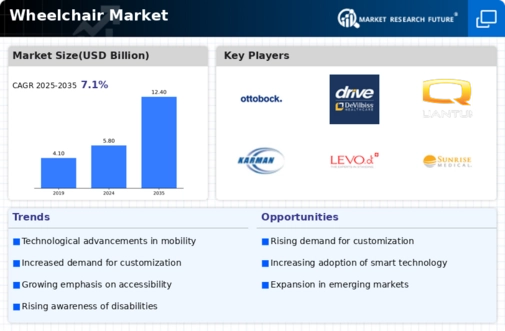Market Trends
Key Emerging Trends in the Wheelchair Market
As individuals age, a decline in the functionality of vital organ systems often accompanies this process, leading to a heightened dependency on assistance for day-to-day activities. A prime example is arthritis, a condition characterized by joint pain that diminishes lower body movement, ultimately restricting overall locomotion. The World Health Organization (WHO) estimates a drastic surge in the global population aged 60 and above, nearly doubling from 12% to 22% by the year 2050. This demographic shift towards an aging population is anticipated to drive an augmented demand for electric wheelchairs, given the mobility challenges faced by older individuals.
According to statistics provided by the United Nations (UN), the global population aged 60 years and above amounted to 703 million individuals in 2019. This number is projected to surpass 1.5 billion by the year 2050. This remarkable increase in the elderly populace is a key driver influencing the burgeoning demand for electric wheelchairs worldwide throughout the forecast period.
The aging process often accompanies various health concerns, such as joint-related issues, mobility limitations, and other physical impairments. Conditions like arthritis or age-related joint pain significantly affect the lower body's range of motion, making movement increasingly challenging for older individuals. As the global population continues to age, there's a growing necessity for advanced mobility aids that offer improved independence and assistance for those with mobility-related limitations.
Moreover, with the rise in life expectancy and improvements in healthcare services, more people are living longer, contributing to the growth of the elderly population. This demographic shift has led to an amplified need for innovative mobility solutions that cater to the specific mobility requirements of the elderly population, thereby driving the demand for electric wheelchairs.
The increasing prevalence of age-related conditions affecting mobility, coupled with the expanding geriatric demographic, has prompted a surge in the demand for electric wheelchairs. These advanced mobility aids provide enhanced mobility, improved independence, and better quality of life for elderly individuals facing challenges in movement and locomotion. Consequently, the anticipated rise in the global aging population is expected to act as a significant catalyst in propelling the growth of the global electric wheelchair market in the foreseeable future.
The aging population, coupled with age-related health conditions affecting mobility, is anticipated to drive a substantial surge in the demand for electric wheelchairs worldwide. The projected demographic shift towards an increasingly older population, as estimated by the WHO and the UN, is expected to significantly contribute to the heightened demand for advanced mobility solutions. As older individuals seek greater independence and improved mobility, the electric wheelchair market is poised for robust growth in meeting the evolving needs of this demographic segment.









Leave a Comment